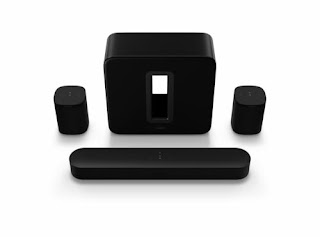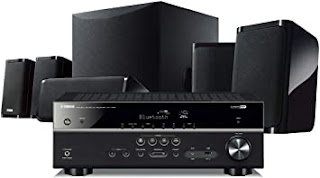5 Best Home Theatre Systems for 2022
In this an article we are going to talk about best 5 home theatre systems you should have in your home. There are three groups of people who buy home theatre systems.
Some people enjoy the process and jump right in, reading about all of the choices, studying how different component combinations produce different outcomes, and so on.
Others are unconcerned with features, specifications, or options; they just want a great home theatre, thank you very much. Then there's the largest community, which includes everyone in the centre.
Our “Best Home Theaters of 2021” guide was written for all, but especially those last two groups. The idea is that you could spend an entire year researching the best home theatre options and yet fall short of our home theatre career professionals' level of experience and expertise.
So why not take advantage of the situation? Here are the best five home theatre system.
⏩Number 1) Nakamichi shockwafe ultra 9.2.4
Nakamichi Shockwafe Ultra 9.2.4 Channel 1000W Dolby Atmos Soundbar With Dual 10 Watt Speakers "Wireless Subwoofers & 4 Rear Surround Effects Speakers Plug & Play Explosive Bass & High-End Cinema Surround are included.
With movies, music, and sports, enjoy the best audio that no other soundbar can match. With our soundbar + four modular surround effects speakers, you can feel the room shaking bass with the industry's first Dual Wireless Subwoofers and 360° 9.2 channel audio from every direction.
In about 30 minutes, this plug-and-play solution will carry the acoustics of a high-performance cinema into your living space.
DUAL 10 is one of our most popular products "WIRELESS SUBWOOFERS (first in the industry! ), the latest soundbar reference standard for bass, deliver earth-shaking rumbles that turn your living room into an adrenaline-pumping action hub.
They combine to disperse bass equally and without localization across the venue. The sound bar, surrounds, and subwoofers recreate the ideal theatre experience, with no distortion at cinema-level volumes.
Each one has a tweeter that reproduces high frequencies with captivating clarity and a full-range driver that delivers surround effects with power and precision (they're connected to the sub through RCA wires).
They are MODULAR in nature and can be customised to suit any room size or shape. Attach them as dipoles to spread extended surround effects, or separate them as four individual speakers to produce our 360° surround sound (signature setup).
With our unique SSE Technology, you can redefine soundbar standards and surround efficiency. Three specialised audio processing engines work together to improve directionality, expand spaciousness, and reveal additional information in any audio soundtrack. Up to 9.2.4 channels of Dolby Atmos or DTS:X object-based multi-dimensional audio flows around, above, and through you in your home theatre.
With 110dB of room-filling music, unleash the full dynamics of your audio experience.
⏩
Number 2) Bose acoustimass 10 series v
Five-speaker output with plenty of room. Bass is really powerful.
The architecture is simple and elegant. For component-minded home cinema fans, the Acoustimass® 10 Series V speaker system has it all.
It's our most powerful Acoustimass system yet, with revamped Direct/Reflecting Series II cube speakers that complement your HDTV.
An advanced Acoustimass® module's resounding bass output allows you to enjoy all of your entertainment even more, every day.
Larger rooms benefit from our best-performing Acoustimass® system, which provides spacious surround sound. The Direct/Reflecting® Series II speakers have been redesigned to have a slimmer profile and can be mounted flush to the wall.
Driven Acoustimass module with two high-performance drivers produces powerful low-note effects. Volume and low-frequency effects controls may be adjusted. For easy setup, cables and connectors are
included and clearly labelled.
Direct/Reflecting speakers have often delivered powerful sound in a compact package. With a slimmer profile and precisely angled drivers inside the speaker for an immersive audio experience, we've made them even better.
They're a perfect fit for your HDTV and can be mounted flush to the wall with the help of optional brackets. They're simple to put together and save nearly 5 cm of wall space as compared to the previous iteration.
A good storey is the foundation of a good film. Good sound effects, on the other hand, make a great movie.
That's where the Acoustimass® module enters the image. It includes proprietary technologies as well as two efficient, downward-firing drivers to deliver the desired effect. Without audible distortion, the sound is pure and intense. And at high decibel levels.
Adjustable controls allow you to customise the low-frequency effects to your taste. You may also conceal the device behind a sofa or a curtain.
Number 3) vizio sb 46514-f6
The SB46514-F6 is similar to the SB36 in terms of design and efficiency, but it has a little more swagger and provides a more immersive listening experience with enhanced Atmos height effects.
The SB46514-F6 5.1.4 device has a larger subwoofer, a soundbar with three tweeters and two passive radiators, and dedicated up-firing height-channel speakers in each of the rear surrounds.
If you're keeping track, that means the SB36512-F6 is missing five speakers and two passive radiators.
The three additional speakers are provided by a trio of 0.79-inch tweeters in the front. Each is paired with a 1.75-by-4.25-inch mid-bass motor, and the left, right, and middle audio channels are made up of them.
The passive radiators, measuring 1.6 by 5.36 inches, are mounted just within the left- and right-channel tweeters. Left and right up-firing drivers measuring 2.33 by 2.95 inches are located in the middle of the soundbar, on either side of the center-channel driver and tweeter.
Vizio has managed to cram all of the components into a neat soundbar that should clear most stand-mounted TVs' IR remote sensors. While it is a foot longer and weighs 1.6 pounds more than the SB36, it is just a fraction of an inch higher and deeper, measuring 2.52 and 3.34 inches, respectively.
The Vizio SB46514-F6 is a full-featured 5.1.4 audio device that sounds fantastic, is simple to set up and run, and seems to be a good deal when compared to other Dolby Atmos soundbars in its price range.
The SB46 has a much larger soundstage, more control, more precise height effects, and a more immersive experience than the SB36512-F6.
The $500 SB36, on the other hand, is so good that buyers — especially those with smaller rooms — will have to determine for themselves if the performance upgrade is worth the extra money.
⏩
Number 4) Sonos 5.1 surround set
High-definition surround sound for home cinema, music, and more will completely transform your room. Link your device to your WiFi network and monitor it using your remote, the app, or your voice.
With cinematic surround sound, you can bring all of your entertainment to life. Link your device to your WiFi network and monitor it using your remote, the app, or your voice.
The Google Assistant and Amazon Alexa are built right in, so you can use them to play music, check the news, set alarms, get answers to your questions, and more. High-quality audio Low and high frequencies are balanced by full-range woofers and tweeters.
Enhancement of speech Switch on speech enhancement to get smoother dialogue and never miss another word. The rhythm of the night Enjoy late-night television without waking up the rest of the family.
HDMI ARC (Audio Return Channel) To power your TV with speech, simply pair your device with your remote. Play all of the things that are important to you.
67 music services are supported, including TV, movies, music, radio, podcasts, audiobooks, games, and AirPlay. Select your preferred mode of operation. Use your voice, the Sonos app, AirPlay, or the app for your favourite music service to control Beam.
Monitor Sonos with your voice using Amazon Alexa.
How does the voice work?
Surround sound can be added without the use of wires. When you wirelessly connect a pair of rear speakers and a Sub, you'll have a home cinema system.
Your Sonos system's wireless subwoofer. High-quality audio Two face-to-face force-cancelling speaker drivers provide a louder, richer sound with no cabinet buzz or rattle.
Style that is exclusive Sub is built to maximise sound quality and look stunning in your home, right down to its distinctive "O" shape. Listen to the bass.
Two custom-designed woofers produce an incredible amount of detailed, dynamic bass. Various orientations You can either stand it tall or lay it flat.
Sub, on the other hand, brings out the bottomless bass you crave. With Sub, everything sounds better. You'll hear parts of your music that you wouldn't hear otherwise when you pair a Sub with any Sonos speaker.
Since Sub does all of the heavy lifting in terms of delivering the lowest frequencies, the other speakers will concentrate on perfecting the mid- and high-range frequencies.
You won't just be able to tell the difference. You'll sense it. There is no vibration.
The problem with moving all that air to produce bass is that it shakes and rattles most subwoofers. Not at all.
To balance out the impact of all that vibration, we put the drivers on opposite sides of the enclosure, face-to-face. All you'll hear is deep, informative bass. The sound system for your home that improves over time.
Link Sonos speakers in various rooms over WiFi to build a home sound system that connects everyone in the house. Software upgrades ensure that the product is still improving.
⏩
Number 5) Yamaha yht-4950 Uv
Bring the living room to life with immersive, cinematic surround sound.
In a single kit, this home-theater-in-a-box system includes a powerful AV receiver, five speakers, a subwoofer, and speaker cable.
This 5.1-channel home theatre system includes an AV receiver as well as a speaker kit (one centre channel, two front channel, two surround speakers, and a subwoofer) to provide crisp, balanced sound for any listening situation.
In one simple system, you can watch all of your favourite movies, TV shows, music, and video games.
HDMI 4K Ultra HD Support The AV receiver in this kit transmits 4K video at 60 frames per second pass-through and is fully compatible with the new HDMI standards. It also supports HDR (high dynamic range) video, such as Dolby Vision and Hybrid Log-Gamma, which offers amazing contrast, smooth sound, and rich, bright colours, allowing you to experience absolute, high-definition entertainment with an extremely realistic and natural picture quality.
YPAO (Yamaha Parametric Room Acoustic Optimizer) analyses the acoustics of your room and your system, then precisely changes different audio parameters to provide the best sound for your room.
The device is automatically tuned for optimal output in your home by putting the supplied microphone at your listening location and turning on YPAO.
Which of the following best 5 home theatre system you find most interesting do let us know down in the comment section below.










